Last week was great. I was in Atlanta at the Training 2009 and got to meet many blog readers who presented me with some interesting elearning challenges. I love it. The problem solving is fun and a great learning opportunity.
During the conversations, one of the things that really stood out was how tough the economy has made it for many in the learning industry. The way it seems to work is that organizations restructure and somewhere in the process the training people are usually the first to go. Even if you don’t get laid off, there’s always the concern that you will. This creates a lot of stress. I had a lot of people ask what they can do to avoid this.
There are few guarantees in life. However, when organizations do make tough decisions they always lean on those things that provide the most value. So if I were to offer any advice, it would be to provide the most value that you can. You don’t want to be seen as an expense to the organization.
The best way to bring value is to align your work to the organization’s core mission. The further you get from meeting those goals, the less value you bring. Unfortunately, training groups typically are reactive to the organization’s goals and not proactive. That means they end up doing a lot of stuff to fix mistakes, rather than promoting ways to move things forward.
If there’s good news in all of this, it’s that rapid elearning brings a lot of opportunity in these tough economic times. There’s a need to do more with less. Rapid elearning fits that bill. Switching from instructor led training to elearning makes sense. And using rapid elearning tools as the starting point makes more sense than hiring costly multimedia developers.
The challenge in all of this is that rapid elearning has to bring real value and isn’t just a bunch of PowerPoint files converted to Flash and then put online. In fact, during the conference, I participated in a Rapid Elearning Shootout with other vendors. The goal was to take a linear PowerPoint file and convert it to engaging and interactive content using our tools.
Articulate won the shootout. However, what I want to focus on is how I restructured the content, because it speaks to ways that you can offer more value to your organization using rapid elearning software.
Not Everything Needs to Have Bells & Whistles
Following is a link to the original version. This type of course is typical of what many of you see in your organizations. While it’s not necessarily the most engaging presentation, it is informative. And believe it or not, a lot of learners like something like this where there are few animations and they can quickly scan the information.
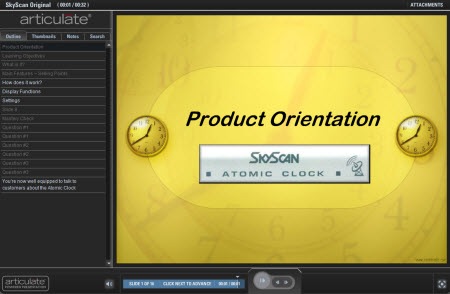
View the original course here.
If this is all your organization wants, then it works. It might not be the perfect course or highly interactive, but you can fight “the man” and argue your case for engaging elearning later when the economy is better.
I already know that some of you are rolling your eyes and saying that this is the worst of elearning. That’s not true. The worst of elearning is paying a Flash programmer to produce something like this for a lot more money. Trust me. I talk to people all the time. I’m amazed at what they’re being charged for basic courses that they could do themselves for a lot less.
By creating rapid elearning courses, you bring value to your organization because you can drive down the cost of production. However, no software replaces the need for sound instructional design.
Convert a Linear Course to Be More Interactive
Now let’s take a look at my version of the same course. I took a typical linear PowerPoint course and converted it to something that is more focused on helping the learner meet the organization’s goal, which is to sell the clock.
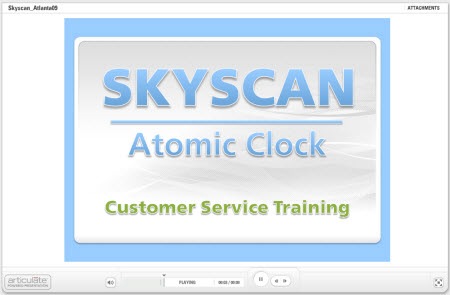
View the updated course here.
As you review it, don’t get hung up on the content which is irrelevant. Instead, focus on how I converted the linear information to something that is a more relevant learning experience. You’ll notice that the approach is generally simple and easy to create. And, you’re not really losing any content.
People aren’t course-deficient. Here’s the deal. Your organization isn’t saying that they want people taking more courses. What they want is that people meet goals. The course is a means to meet those goals. Focus on that outcome and not on just creating elearning courses.
- The goal of the course is that the learner is able to sell Skyscan clocks. I restructured the info-centric slides to be more customer-focused. I felt that the original file was too focused on the clock information and not enough on working with a customer to sell the clock. So I broke the info into three sections focused on product information, sales opportunities, and customer FAQs. I also made the assessment based on a customer interaction rather than a pure knowledge check. You’ll notice that the content isn’t much different, it’s just restructured.
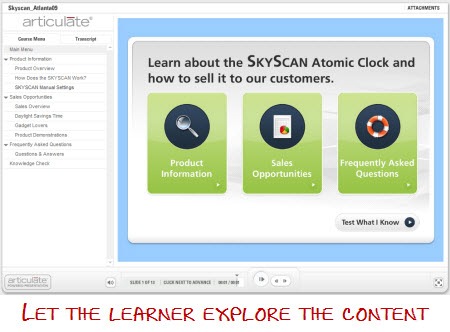
- I freed up the navigation so that the course seemed more exploratory and less like a linear course. That gives the learner the opportunity to go where they want rather than me forcing them all to go down the same path. Clicking on slides in a linear order has nothing to do with them selling the clocks. Ultimately, they pass or fail by selling product.
- I gave the learners immediate access to the assessment. As I stated earlier, my concern is less about the learners “taking the course” and more about them being able to sell the product. My measure of success is not slides viewed. It’s that through the assessment they can demonstrate the level of understanding they need to be effective at selling clocks.
Because you are limited to PowerPoint doesn’t mean you can’t build effective elearning. I converted some of the slide content to Engage interactions, but for the most part the essence of this course is created in PowerPoint, including most of the graphics. That’s a big time saver.
Many of you are limited to PowerPoint and don’t have access to Flash programmers. That’s OK because the rapid elearning tools fill the gap. It just requires that you make the most of the tools you have. You’ll save time and money, build better courses, and be an asset to your organization.
-
A large part of elearning is visual design. If you want your learners engaged, make sure you start with an inviting design. If the original was an orientatio
n course for new members of the
Illuminati, I might have kept the color scheme. However, for my rework I opted for an open and inviting feel. I used a larger font size, lighter colors, and a lot less text.
-
The first interaction where you have to click on the Skyscan interface is built entirely in PowerPoint. If you click on the wrong spot, you are bumped to a reject slide. You can only advance forward by clicking on the correct part of the interface. In this interaction, I wanted to show that you can build effective scenarios and interactivity without other tools. I also didn’t bother explaining the display. If I am telling the customer that the display is intuitive and easy to read, then I shouldn’t need a big long explanation of how to read it.
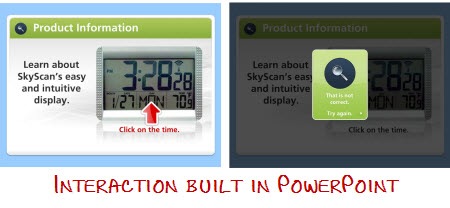
- As a bonus, I even used PowerPoint to create Flash animations by publishing the slides in Articulate Presenter. Then I pulled the slide’s flash file (.swf) from the data files and used them in my Engage interactions. That’s another big time saver and effective use of the tools you have.
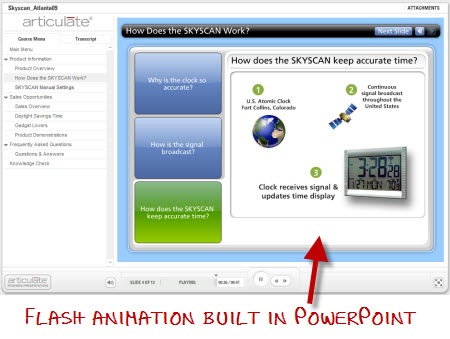
Why are we training people to sell clocks to Alex Trebek? I don’t want to disparage the other shootout entries (or those who use Jeopardy games) but it seems like any time you mention elearning and interactivity, someone pulls out a Jeopardy-style game. What’s up with that? What did the training industry do before Jeopardy? I wish I had been working during the Gong Show era. That would have made for some good elearning. 🙂
Games can have a place in the learning process. However, you add more value to your organization if you design your learning interactions to match the desired outcome of the training. Where do Jeopardy, crosswords, and matching puzzle pieces fit in the process? Don’t just throw a game into your course because you can. They can distract from your goals rather than enable them.

Assess your learners on what they need to do. The original quiz questions are based on the product. I changed the focus from the product to answering customer questions. I still cover the same information, but am better off putting it in context to how the learner would use it.
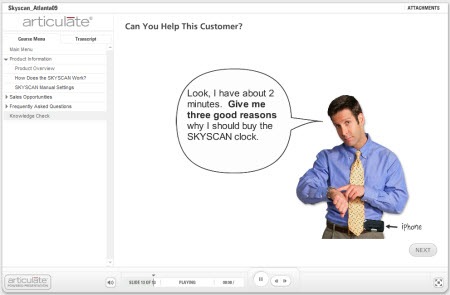
Streamline the objectives. I replaced the bullet point objective list with a simple and clear statement. By dividing the content into sections, the learner can figure out what’s covered in the sections.
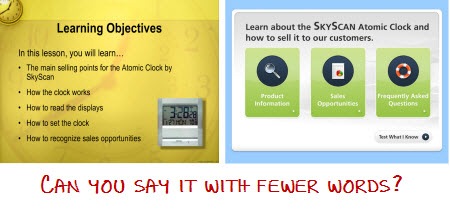
Summarize the course by what actions you want them to take. I added a simple action items slide to help them focus on the essence of that section. Many people zone out during the course and can lose sight of its purpose. A simple summary built on what they should do with the information helps.
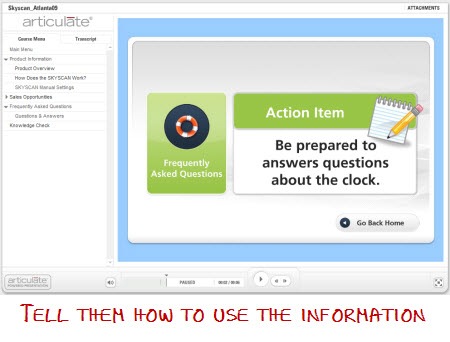
Provide additional resources to the learners. One of the problems with elearning courses is that they are locked and tracked. Many times, after the course the learner can’t revisit the content. The irony is that one of the benefits of online learning is the asynchronous access to information and training.
In this case, I created an attachments section where I provided a link to a web site and owner’s manual for more information. It’s available to those learners who want them.

As you can see, there are simple things you can do to convert a linear course that is focused on information and convert it to something that is more focused on the outcome.
The first rule of engagement is context and relevance. You can get away with a simple linear course if the information means something to the learner. However, you can’t mask irrelevance with games and gimmicky tricks. If anything it is more a waste of the organization’s time and resources. The course means nothing to the learner as a game if it means nothing to them in the real world.
Focus on courses that bring value by aligning the objectives with the organization’s goals. By doing so, you demonstrate your value and stand a better chance of retaining your position in these tough economic times.
What would you recommend to your peers to demonstrate value to the organization? Click here to share your thoughts.
Events
Free E-Learning Resources

















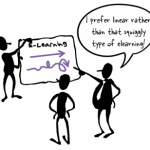







0
comments